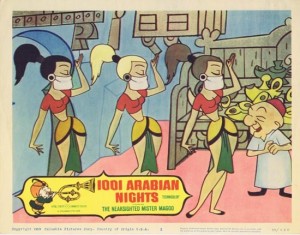
John Ryan Kinney is best known as the director of Der Fuehrer’s Face (1942), one of the most popular of all World War II cartoons and certainly and one of the most iconic films made during that era. However, it was not a film that Kinney really thought much of, telling Michael Barrier and Milt Gray in a 1973 interview, “I never thought it was a good picture. It won the Academy [Award], but it was just another picture. Except the tune; I think the tune was great.” The film, though, has worn well and I found it always got a strong response whenever I showed it to my students.
What he did like was his much admired Goofy how-to series, which included How to Ride a Horse, first shown as part of The Reluctant Dragon (1941), Motor Mania (1950) and Hockey Homicide (1945)—the subject of one of Devon Baxter’s Breakdowns in December.
He attended John C. Fremont High School in Los Angeles, where he played football with his friend Roy Williams, who also went to work for Disney. Kinney started out as an inbetweener at Disney in 1931 under a contract that stated he was being hired as an “apprentice cartoon animator” at $20.00 a week, with raises every 3-6 months until he reached $50.00. That February 9th agreement, minus a page, can be found on Michael Sporn’s Splog; it seems Kinney originally wanted to include it and a bunch of other marginalia as part of a longer version of his widely-praised memoir, Walt Disney & Assorted Other Characters: An Unauthorized Account of the Early Years at Disney’s (1988).
Kinney eventually became an animator on such shorts as Santa’s Workshop (1932) and The Band Concert (1935) before becoming a storyman on films like The Brave Little Tailor (1938), where he claims to have devised the Leica reel. He then moved on to directing, starting with Pinocchio (1940); this was unusual at the time, since the conventional route to directing at Disney then was from the ranks of senior character animators rather than from the Story Department.
 In 1940, starting with Bone Trouble (1940) he also directed shorts, and alternated between them and feature projects for the next few years. It was his short films that seemed to give him the most satisfaction, since Disney was too preoccupied with feature films to pay much attention to them. Kinney was laid off when the shorts unit was shut down in 1957.
In 1940, starting with Bone Trouble (1940) he also directed shorts, and alternated between them and feature projects for the next few years. It was his short films that seemed to give him the most satisfaction, since Disney was too preoccupied with feature films to pay much attention to them. Kinney was laid off when the shorts unit was shut down in 1957.
He then went on to direct UPA’s first feature, Mr. Magoo’s 1001 Arabian Nights, after which he started his own studio, Jack Kinney Productions, which did over 100 of the first made-for-TV Popeye cartoons for King Features, which did not necessarily represent his finest hour.
My video interview for the 1984 Golden Awards Banquet was, admittedly, not that informative, but he does talk with affection about his recent experience in teaching young Navajo artists, in Gallup, New Mexico; he said, “We had a ball. We really enjoyed it.” (This episode was briefly referenced here by Jim Korkis.)
By the way, Michael Barrier has promised to post a second interview with Kinney (and his wife Jane) from 1976 in the near future.
Next week: Larry Silverman and Jack Ozark.


 Harvey Deneroff is an independent film and animation historian based in Los Angeles specializing in labor history. The founder and past president of the Society for Animation Studies, he was also the first editor of Animation Magazine and AWN.com. Harvey also blogs at deneroff.com/blog.
Harvey Deneroff is an independent film and animation historian based in Los Angeles specializing in labor history. The founder and past president of the Society for Animation Studies, he was also the first editor of Animation Magazine and AWN.com. Harvey also blogs at deneroff.com/blog.




































































The belly-laughs produced by Jack Kinney’s book are many but the crowning one is the Mike Meyers’ presentation of his Donald Duck storyboard. Pages 64 and 65 to help guide the curious.
You mean the story where an irritated Mike goes through his Donald Duck storyboards using fowl language (pun intended)?
My high school had the book at their library.
I was executive secretary to Jack Kinney and Bernie Wolf in the late 60s at Kinne-Wolf near The Shack Restaurant which we frequented. It was a great job and Jack and Bernie were wonderful employers.